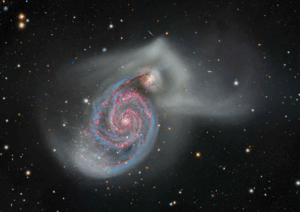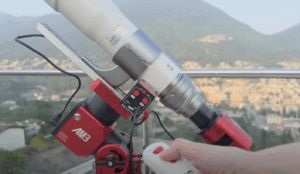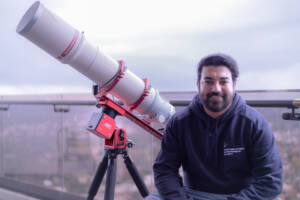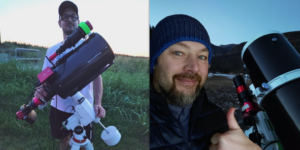
Discovery of the M31 [OIII] emission arc
Recently, a major discovery by an international team of amateur astronomers and scientists has become a huge online hit, and this new discovery is just located in one of the

Thank you very much!
I am Daniele Gasparri, an astrophysicist, astrophotographer and author of many astronomy books. I work at the University of Atacama, in the middle of the Atacama Desert, Chile, the best place in the world to observe the night sky. As a professional astrophysicist, my main topics are galaxies from the observational point of view. I’ve been in the Atacama Desert for 4 years. In my spare time, I love to explore the desert and to take astrophotography through the telescope and with wide-field lenses.
Modern astrophotography is a very powerful tool both for communication and science. I made astrophotography for science in the past, discovering a couple of variable stars and a transiting exoplanet. Now, I mostly do it for fun and for communication purposes. It is unbelievable what we can do now: with cheap equipment and an internet connection, we can share the wonder of the Universe anywhere in the world.
I started astrophotography when I was in high school, in 1998, with film cameras! Actually, I did not have money to buy a reflex, so I stole a compact camera from my mother and modified it for long exposures. My first image was a simple star trail of the planet Jupiter with a single two-hour exposure. When I saw the image after some very long days of waiting, I could not believe my eyes. At that moment I understood the power of astrophotography to show the infinite wonders of the Universe behind the limited sensitivity of our eyes.
Here in the Atacama Desert, I use a very simple and relatively cheap setup: a 130 mm Newtonian telescope on an old fashion (but working) EQ5 mount and the ASI2600MC Pro camera. I have a ZWO OAG and a small, but powerful ASI224MC as the guide camera.
That’s all you need!
Thank you! Well, when you live in the driest desert of the world where there are more than 320 clear nights per year, with sub-arcsecond average seeing and no light pollution, things are a bit easier and Comet Leonard helped a lot since it was well-visible with the naked eye. Actually, I must say that during the best visibility of Comet Leonard, I lost a couple of days because of clouds! But I am still very satisfied.
Every image of the Comet Leonard is an average of 5-6 single shots with 2-minutes exposure time. I could not integrate more because the comet was moving very fast with respect to the stars. Basic processing has been made, like dark and flat frame calibration, stretching and color adjustment.
I started writing in 2007 for an Italian astronomy magazine and I really enjoyed it, so I started to write books on my own. My first book was published in 2011 and since then I wrote almost every day. My books, unfortunately, are in Italian, except for two that have been also translated into English. There are practical books where I teach to observe and photograph the Universe and some more theoretical ones about the principles of astronomy and astrophysics. Practical or theoretical, my goal is to make astronomy as accessible as possible for everyone; that’s why I started writing and continue to do so. When someone can see the beauty of the Universe because of my books, I feel very satisfied. More people in the world should look up and understand a few things to make this Planet a better place.
The idea of a page came to me when I moved to the Atacama Desert and saw the incredible beauty of this sky. In two weeks, I managed to collect more astrophotos from Atacama than in years from the poor Italian skies where I came from. The internet was (and still is) full of spectacular images taken with the largest telescope in the world but I wanted to show that also with modest equipment the Universe can be marvelous. On my page, I share my adventure in the Atacama Desert and the pictures of the Universe I take mostly from here, with regards to the emotional part. I think that people like my page because I share not only images but also what I feel by looking at these incredible pieces of the Universe captured with my cheap equipment.
I have a secret (more or less!) spot about 70 km from the city where I live, Copiapó, the capital of the Atacama region. It’s a Bortle 1 sky with superb seeing, far from the main roads. I go there at least one week every month during the new Moon to take pictures with the telescope.
When I want to take night landscape images, I often travel to the Cordillera de los Andes, about 170 km from my city, easily reaching 5000 meters of altitude. There, if you can breathe, you will see an amazing night sky.
There are many experiences that I could share with you, but I choose this one.
It was one night as many. I was about to start my astrophotography session in the middle of the desert, 70 km from the nearest city. A car passed by on the near road, then stopped a few hundred meters after my spot and went back straight to where I was standing with my telescope. A man went out and started to walk towards me. I was a little scared because I was alone, with no mobile phone signal and no one knew I was there. Suddenly this man, still hidden in the dark, started screaming: “Wow, this is a telescope? Man, this is a real telescope?? I cannot believe it!” In one second, I understood that there was nothing to fear. This man was astonished to see me there, in the middle of nowhere, to look at the stars. I talked with him for at least half an hour. He explained that he worked in a mine, but he had a huge passion for the Universe since he moved to Atacama and saw this impressive sky. It was a very surprising talk, a demonstration that people want to know about astronomy, once they can see the stars instead of the light pollution.
For me, it’s the fast movement in the sky, that makes it difficult to perform long integration times to capture the faintest details. If you align the images on the false nucleus, the stars will show trails. If you align to the stars, the comet will be blurry. There are some advanced techniques to merge the stars and the comet, but they are very invasive, and the results are not always perfect. So, the best way to capture a comet is to go under very dark sky, with a very sensitive camera and a low f ratio telescope, in order to collect as many photons as possible before the movement of the comet shows up in the images.
Don’t spend all your money on larger telescopes and complicated electronics, because if you don’t have experience and a dark sky, you will never reach great results. There is no telescope that can give to you experience and dark skies. Cheap and easy-to-use equipment with good quality sky is always better than a Hubble-like telescope used in the city. So, if you don’t live under a dark sky, try to save money to travel to the darkest place you can reach, instead of buying very expensive equipment. My setup is relatively cheap, ready in 10 minutes and under the sky of the Atacama Desert gives me unbelievable results, impossible to reach from light-polluted locations.

The ASI2600MC Pro is impressive. I used for many years very expensive science grade CCD monochrome cameras with high noise and small chip size. The ASI2600MC Pro is a revolution. With a fraction of the cost of old CCD cameras, you can have a huge sensor, one-shot color and very low noise. High-level astrophotography is finally more accessible than ever.
As a scientist, I am very interested in the potential of the new generation of CMOS detectors, but the commercial offer lacks a product optimized for scientific purposes. I would like to see one day a full-frame (or APS-C) monochrome camera with larger pixel sizes, around 7-8 microns. This camera will be even more sensitive and with a huge full well capacity with respect to the actual small pixel size detectors and could be used for transient object surveys (supernova, nova, variable stars), as well as for high precision photometric applications. The high framerate of the CMOS detectors will also allow high precision timing applications, for example in the study of lunar and asteroid occultations. The CMOS has a great, still unexplored, potential in amateur research. We just need an optimized camera for that.
During the four years in the Atacama Desert, I accomplished more than I could even imagine. Besides the stunning skies, I witnessed two total solar eclipses, one beautiful comet and two total lunar eclipses: that’s more than in an entire lifetime! My goal for 2022 is then very simple: I want to continue to enjoy at maximum this sky because one day, not far, I will go back to Italy, and I will miss forever this place.
My impression of ZWO is very positive. In the future, I just hope that ZWO will keep astrophotography as accessible as possible to everyone. Because there is a need for astronomy, there is a need for beauty and there is a need for wonder. All this is possible thanks to astrophotography.

Recently, a major discovery by an international team of amateur astronomers and scientists has become a huge online hit, and this new discovery is just located in one of the

I was born in Guadalajara, I’m 38 years old, a musician, communications and electronics engineer, and president of the Guadalajara Astronomical Society A.C. since 2020. First Contact with Astronomy Since

This stunning collaborative project comes from astrophotographers Alex Linde and Thomas Hansson, who joined forces across borders to photograph the Whirlpool Galaxy from Sweden, Poland, and Texas, USA. Thomas traveled across


“Two thoughts immediately crossed my mind—the vastness of the cosmos, and that I could also create images like the ones that inspired me.” ” If you spend more time debugging than

Starting the Journey For Giovanni Pasquetto, the passion for the cosmos began in 2007 when he bought his first telescope—a small Newtonian—for his son. That initial curiosity sparked a love